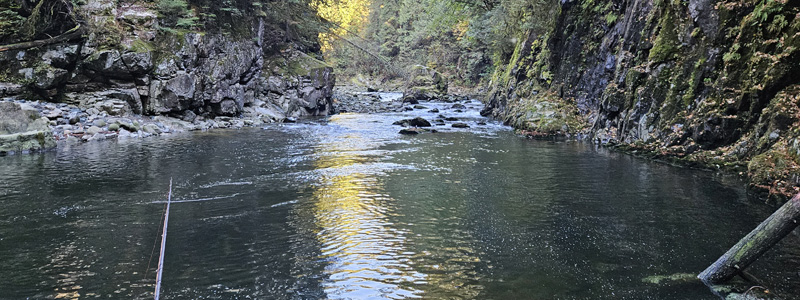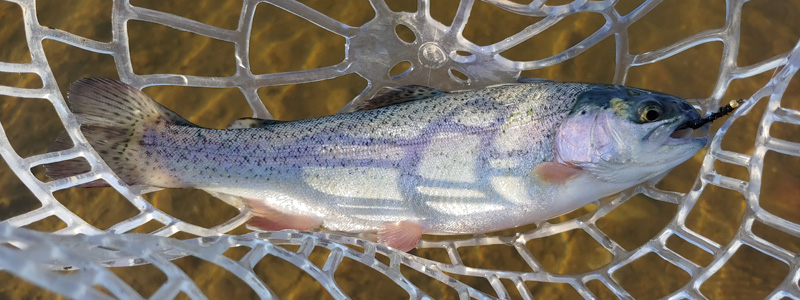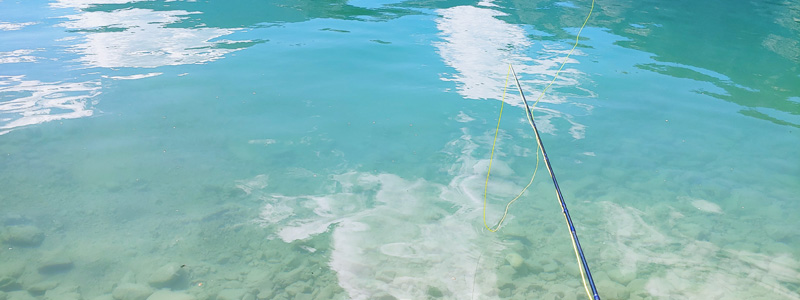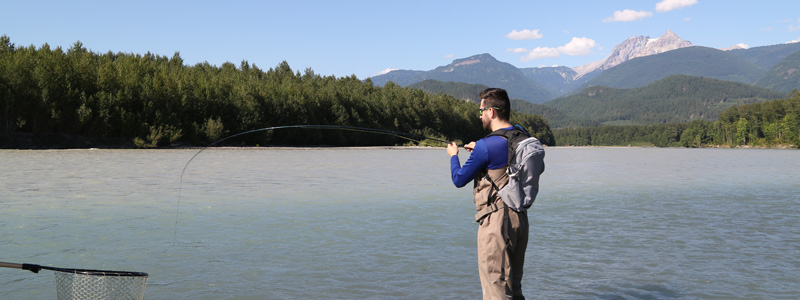Fly fishing mountain streams for rainbow trout is an exhilarating experience that combines skill, strategy, and the beauty of nature. In this comprehensive guide, we’ll share expert tips to help you master the art of mountain trout fishing and increase your chances of landing that prized rainbow trout.
What Makes Mountain Stream Fly Fishing Unique?
Fly fishing mountain streams for rainbow trout is an exhilarating experience that sets itself apart from other types of angling. The unique characteristics of these environments create both challenges and rewards for the dedicated fly fisher.
Mountain streams are typically characterized by their crystal-clear waters, swift currents, and diverse underwater structures. These features make for ideal rainbow trout habitat but also demand a different approach from anglers. The clarity of the water means that trout can easily spot predators, including fishermen, making stealth a crucial element of success.
One of the biggest challenges in mountain stream fishing is navigating the terrain. Steep banks, slippery rocks, and dense vegetation can make accessing prime fishing spots difficult. However, this rugged beauty is also part of what makes the experience so rewarding. The solitude and pristine surroundings often found in mountain environments add an extra layer of enjoyment to the fishing experience.
Adapting your techniques for mountain trout fishing is essential. The fast-moving water and confined spaces require precise casting and quick thinking. You’ll need to read the water carefully, identifying pockets where trout might be holding and adjusting your presentation accordingly.
How Do You Read Mountain Streams for Rainbow Trout?
Successfully fly fishing mountain streams for rainbow trout begins with the ability to read the water effectively. This skill allows you to identify prime trout holding areas, understand current patterns, and recognize feeding zones.
When looking at a mountain stream, focus on areas where trout are likely to hold. These include:
- Pools: Deeper, slower-moving sections where trout can rest.
- Riffles: Shallow areas with broken water where insects are often abundant.
- Runs: Stretches of swift, smooth water between pools and riffles.
- Undercut banks: Areas where the water has eroded the bank, creating overhead cover.
- Boulder pockets: Spaces behind or beside large rocks where trout can hide from the current.
- Walking speed water: Look for where the currents seem to be having a normal / casual walking speed. These can be good for the drifting style of fly fishing
- Look for the “food highways” which can be usually identified through a long line of scum / foam, and debris floating downstream. These can be very productive spots, as many insects / fish food can be pushed downstream along with all other debris (very commonly accompanied by the white or dirty foam).
Understanding current patterns is crucial in mountain stream fishing. Look for seams where fast and slow water meet, as these are often prime feeding lanes for trout. Also, pay attention to eddies and back currents, which can hold fish looking for an easy meal.
Natural structures like fallen trees, root wads, and large boulders create excellent holding spots for trout. These features provide cover from predators and relief from strong currents, making them ideal places to target when fly fishing mountain streams.
What Are the Best Flies for Mountain Stream Rainbow Trout?
Selecting the right flies is crucial when fly fishing mountain streams for rainbow trout. Your choice should be influenced by the time of year, water conditions, and the feeding habits of the trout in your specific location.
Dry Flies
Dry flies are excellent choices for mountain streams, especially during warmer months when trout are more likely to feed on the surface. Some popular dry fly patterns include:
- Elk Hair Caddis
- Parachute Adams
- Royal Wulff
- Stimulator
- Foam Ant or Beetle patterns
These flies imitate adult insects that have emerged from the water or terrestrial insects that have fallen in.
Nymphs
Nymphs are subsurface flies that imitate immature aquatic insects. They’re effective year-round but especially useful when there’s no visible surface activity. Some effective nymph patterns for mountain streams include:
- Pheasant Tail Nymph
- Hare’s Ear Nymph
- Prince Nymph
- Copper John
- Zebra Midge
Streamers
Streamers imitate small fish or large aquatic insects and can trigger aggressive strikes from bigger trout. While not as commonly used in small mountain streams, they can be effective in deeper pools or when targeting larger fish. Consider:
- Woolly Bugger
- Muddler Minnow
- Sculpzilla
- Zonker
- Electric Leech (one of our favorite + go-to’s year-round)
Seasonal Fly Selection Tips
Spring: Focus on nymphs and emerger patterns as aquatic insects become more active.
Summer: This is prime time for dry fly fishing, but don’t neglect nymphs and terrestrial patterns.
Fall: Streamers can be particularly effective as trout become more aggressive before winter.
Winter: Smaller nymphs and midges are often the go-to choices in colder months.
Remember, the best flies for mountain streams can vary depending on your specific location and the preferences of the local trout population. It’s always a good idea to check with local fly shops or experienced anglers for recommendations.
Which Mountain Stream Fishing Techniques Are Most Effective?
When fly fishing mountain streams for rainbow trout, several techniques prove particularly effective. These methods are designed to overcome the challenges presented by fast currents, tight spaces, and wary fish.
High-stick Nymphing
High-stick nymphing is a technique that allows for better control and a more natural drift in fast-moving mountain streams. Here’s how it works:
- Use a longer rod (9-10 feet) for better reach and line control.
- Keep most of your fly line off the water by holding the rod high.
- Use a short leader (usually no more than the length of your rod) with one or two nymphs (make sure local regulations allow more than 1 hook per line!).
- Allow the nymphs to drift naturally with the current, watching your leader for any subtle movements indicating a strike.
This technique is especially effective in pocket water and runs where trout hold in specific feeding lanes.
Dry-dropper Rigs
The dry-dropper rig combines the excitement of dry fly fishing with the effectiveness of nymphing. Here’s the setup:
- Tie on a buoyant dry fly as your primary fly.
- Attach a nymph to the bend of the dry fly’s hook using a piece of tippet.
- Adjust the length of the dropper based on the depth of the water you’re fishing.
This method allows you to cover two feeding zones simultaneously and can be particularly effective when trout are feeding both on and below the surface.
Roll Casting in Tight Spaces
Mountain streams often have overhanging vegetation that makes traditional overhead casting difficult. Roll casting is an essential skill for these situations:
- Start with your fly on the water in front of you.
- Lift your rod tip to about 2 o’clock position, allowing some line to drape behind you.
- Make a smooth, accelerating forward stroke, stopping abruptly at about 10 o’clock.
- The line will roll out in front of you, placing your fly where you want it.
Practice this technique to effectively present your flies in tight spots without getting tangled in bankside vegetation.
Stealth Approaches for Wary Trout
Mountain stream trout, especially in clear water, can be extremely wary. Employ these stealth tactics:
- Wear muted colors that blend with the surroundings.
- Approach from downstream whenever possible, as trout face upstream.
- Use natural features like boulders for cover as you move along the stream.
- Minimize false casting to avoid spooking fish.
- Consider using longer leaders (12-15 feet) in very clear water to keep your fly line farther from the fish.
By mastering these mountain stream fishing techniques, you’ll be well-equipped to tackle the challenges of fly fishing for rainbow trout in these dynamic environments.
How Do You Choose the Right Gear for Fly Fishing Mountain Streams?
Selecting the appropriate gear is crucial when fly fishing mountain streams for rainbow trout. The right equipment can make a significant difference in your ability to present flies effectively and handle fish in fast-moving water.
Selecting Appropriate Rod Length and Weight
For mountain streams, shorter rods are generally more practical due to the tight quarters and overhanging vegetation. Consider these factors:
- Rod length: 9′ to 10′ rods are ideal sizes for most mountain stream situations, as well as many other applications.
- Rod weight: 5 – 6 weight rod combo kits are a perfect blend of delicate presentations and power for when you inevitably run into big trout.
- Action: Fast or medium-fast action rods provide better accuracy in windy conditions and help with quicker hook sets in swift currents.
Choosing the Best Line and Leader Setup
Your line and leader setup is critical for presenting flies naturally in clear mountain waters:
- Fly line: Weight-forward floating lines match well with the recommended rod weights and provide good control for various casting techniques.
- Leader: Use longer leaders (9-12 feet) for increased stealth in clear waters. Tapered leaders help with more delicate presentations.
- Tippet: 2X to 5X tippets are typically suitable for mountain stream fishing, depending on the size of flies you’re using, the wariness of the trout, whether they are stocked or wild, and their size. We noticed that wild trout do not seem to be as scared by line as their stocked counterparts, so we usually go with a stronger monofilament / fluorocarbon leader for big trout.
Essential Accessories for Mountain Fishing
Don’t forget these crucial accessories for a successful and comfortable day on the mountain stream:
- Waders and wading boots: Breathable waders and sturdy boots with good traction are essential for navigating slippery rocks. Optional, but if they are within your budget, they pay for themselves.
- Fishing vest or pack: Choose one with plenty of pockets for organizing your gear.
- Forceps and nippers: For removing hooks and trimming line.
- Floatant and sink putty: To treat dry flies and weight nymphs as needed.
- Polarized sunglasses: These help reduce glare and allow you to see into the water more clearly.
- First aid kit: Safety should always be a priority in remote mountain locations.
- Food & water: Stay hydrated and fed. The overheating and hunger headaches are NOT fun, speaking from experience…
By carefully selecting your gear with mountain stream conditions in mind, you’ll be well-prepared for the unique challenges of fly fishing for rainbow trout in these environments.
What Are the Top Safety Considerations When Fly Fishing Mountain Streams?
Safety should always be a top priority when fly fishing mountain streams for rainbow trout. The remote nature of these locations and the potential for rapidly changing conditions require anglers to be well-prepared and vigilant.
Navigating Slippery Rocks and Swift Currents
Mountain streams can be treacherous due to slippery rocks and fast-moving water. Here are some tips to stay safe:
- Wear studded wading boots for better traction on slick rocks.
- Use a wading staff for extra stability, especially when crossing deeper sections.
- Always face upstream when wading and move diagonally across currents.
- Test each step before committing your full weight.
- Don’t wade deeper than mid-thigh in swift currents.
- Be VERY careful while wading, especially in faster water. Remember, a fish is not worth your life. If it’s just outside of reach with fast water between you and it, let it be, there will always be a next time.
Dealing with Changing Weather Conditions
Mountain weather can be unpredictable and change rapidly. Be prepared by:
- Checking the weather forecast before your trip.
- Dressing in layers to adapt to temperature changes.
- Carrying rain gear even on sunny days.
- Being aware of the signs of approaching storms, such as darkening skies or sudden wind changes.
- Knowing when to call it a day if conditions become unsafe.
Essential Safety Gear for Mountain Fishing Trips
Don’t venture into the mountains without these safety essentials:
- First aid kit: Include treatments for cuts, sprains, and insect bites.
- Emergency shelter: A lightweight tarp or emergency blanket can be a lifesaver.
- Fire starting materials: Waterproof matches or a lighter, and fire starter.
- Navigation tools: Map, compass, and/or GPS device (with extra batteries).
- Communication device: Cell phone (though service may be limited) or satellite communicator.
- Headlamp or flashlight: In case you’re out later than expected.
- Extra food and water: Always pack more than you think you’ll need.
- Whistle: For signaling in case of emergency.
Remember, it’s always safer to fish with a buddy when in remote mountain areas. If you do go alone, make sure to let someone know your plans and expected return time.
How Can You Improve Your Casting Accuracy in Mountain Streams?
Accurate casting is crucial when fly fishing mountain streams for rainbow trout. The confined spaces and often wind-affected conditions can make precision challenging, but with practice and the right techniques, you can significantly improve your accuracy.
Techniques for Casting in Tight Spaces
-
- Roll Cast: As mentioned earlier, this is an essential technique for tight spots. Practice to achieve consistent, accurate placement.
- Bow and Arrow Cast: For extremely tight spaces:
- Hold the fly between your thumb and forefinger.
- Pull the leader back, bending the rod like a bow.
- Release the fly to shoot it forward accurately.
- Side Arm Cast: Useful when there’s no room for an overhead cast:
- Keep your casting motion parallel to the water.
- Use a more open loop to avoid hitting the water on your back cast.
Dealing with Overhanging Vegetation
- Adjust your casting plane: Tilt your cast to either side to avoid branches.
- Use a shorter leader: This gives you more control in tight spots.
- Practice curve casts: These allow you to cast around obstacles.
Precision Placement for Skittish Trout
- Aim for the “target”: Focus on a specific spot just upstream of where you think the trout is holding.
- Control your line speed: Slower line speed often results in gentler, more accurate presentations.
- Use a reach cast: This technique allows you to place your fly accurately while managing line drag.
Remember, improving casting accuracy is all about practice. Spend time honing these skills before your mountain stream fishing trip, and you’ll see the benefits when targeting those wary rainbow trout.
What Are the Best Times to Fish Mountain Streams for Rainbow Trout?
Understanding the best times to fly fish mountain streams for rainbow trout can significantly increase your chances of success. Factors like seasonal patterns, daily timing, and hatch cycles all play crucial roles in trout behavior and feeding habits.
Seasonal Patterns and Trout Behavior
Spring: As water temperatures rise, trout become more active. This is often the best season for mountain stream fishing.
- Focus on afternoons when the water has warmed up.
- Look for hatches of mayflies, caddisflies, and midges.
Summer: Trout seek cooler, oxygenated water.
- Fish early mornings and evenings to avoid the heat of the day.
- Target riffles and pocket water where oxygen levels are higher.
Fall: Trout feed heavily to prepare for winter.
- This can be an excellent time for larger flies like streamers.
- Be aware of spawning periods and avoid disturbing redds (spawning beds).
Winter: Trout are less active but still feed.
- Focus on the warmest part of the day, usually early afternoon.
- Use smaller flies and fish deeper, slower water.
Optimal Times of Day for Mountain Fishing
Early Morning: Often productive, especially in summer.
- Look for emerging insects and rising trout.
Mid-Day: Can be slow, particularly in summer, but good in spring and fall.
- Focus on shaded areas and deeper pools.
Evening: Usually the best time for dry fly action.
- Watch for spinner falls and caddis hatches.
Understanding Hatch Cycles in Mountain Environments
Hatch cycles in mountain streams can be less predictable than in larger rivers, but understanding them can lead to exceptional fishing:
- Mayflies: Often hatch mid-morning to early afternoon.
- Caddisflies: Many species emerge in the evening.
- Stoneflies: Can hatch sporadically throughout the day.
- Midges: May hatch at any time, often in the morning and evening.
Keep a hatch chart specific to your fishing area and pay attention to what’s happening on the water. Sometimes, the best strategy is simply to observe the stream for a few minutes before tying on a fly.
By considering these factors and planning your fishing times accordingly, you’ll maximize your chances of success when fly fishing mountain streams for rainbow trout.
How Do You Practice Ethical Fly Fishing in Mountain Streams?
Ethical practices are crucial when fly fishing mountain streams for rainbow trout. These fragile ecosystems require careful stewardship to ensure they remain healthy for future generations of anglers and wildlife.
Catch and Release Best Practices
Proper catch and release techniques help ensure the survival of released fish:
- Use barbless hooks: They cause less damage and are easier to remove.
- Land fish quickly: Prolonged fights exhaust fish, reducing their survival chances.
- Keep fish in the water: Minimize handling and air exposure.
- Wet your hands before touching fish: This protects their protective slime layer.
- Support the fish’s body: Don’t hold them by the gills or tail.
- Revive the fish before release: Face it upstream in gentle current until it swims away on its own.
Minimizing Impact on Fragile Mountain Ecosystems
- Stay on established trails: This prevents erosion and protects vegetation.
- Pack out what you pack in: Leave no trace of your visit.
- Avoid walking on underwater vegetation if possible: This can damage important trout habitat.
- Clean your gear between fishing trips: This prevents the spread of invasive species.
Respecting Local Regulations and Conservation Efforts
- Know the rules: Familiarize yourself with local fishing regulations before your trip.
- Observe catch limits: Even if practicing catch and release, respect daily limits.
- Be aware of protected species: Some streams may have special regulations to protect certain trout populations.
- Support local conservation efforts: Consider joining or donating to local conservation groups.
- Report violations: If you witness poaching or other illegal activities, report them to authorities.
By practicing ethical fly fishing, you’re not only ensuring a sustainable future for the sport but also enhancing your own experience by connecting more deeply with the natural world around you.
What Are Some Advanced Strategies for Targeting Large Rainbow Trout?
While mountain streams are often associated with smaller trout, they can also hold some surprisingly large rainbow trout. Targeting these trophy fish requires patience, skill, and specific strategies.
Locating Trophy Trout in Mountain Streams
- Focus on deeper pools: Larger trout often hold in the deepest parts of pools, especially during the day.
- Look for structure: Big trout prefer areas with plenty of cover, such as undercut banks, large boulders, or fallen trees.
- Fish during low light conditions: Dawn and dusk are prime times for big trout to feed more actively.
- Target confluences: Where two streams meet often creates prime holding water for larger fish.
Tailoring Presentations for Selective Feeders
- Size up your flies: Larger trout often prefer bigger meals. Don’t be afraid to use larger nymphs or streamers. Having said that, do experiment if you don’t get bites! We caught some impressive trout on some very small hook sizes (think sizes 10 – 12).
- Improve your drift: Big, selective trout demand perfect presentations. Focus on achieving drag-free drifts.
- Use terrestrial patterns: In summer and fall, large trout often key in on terrestrial insects like grasshoppers and beetles.
- Try mouse patterns: At night, big trout may feed on small rodents that fall into the stream.
Patience and Persistence in Challenging Conditions
- Observe before fishing: Spend time watching the water for signs of feeding activity.
- Make fewer casts: Don’t waste a lot of time trying to make the perfect cast. 100 casts that land in the water give you better odds than 10 perfect casts. Yes, perfect casts make the presentation better, but sometimes you don’t need perfect, you need good-enough.
- Be prepared to change tactics: If one approach isn’t working, be willing to switch up your flies or techniques. We usually go with the 15 – 20 minute approach. If there is no action within 20 minutes of using 1 fly and / or technique, we switch up (faster / slower retrieves, new flies, etc.).
- Stay mobile: Cover water efficiently, giving each promising spot a thorough but not excessive amount of attention.
Remember, when targeting large rainbow trout in mountain streams, the challenge is part of the reward. Even if you don’t land a trophy, the skills you develop in the process will make you a better angler overall. At the end of the day, fishing should be about relaxation and inner peace. It can be frustrating when you get skunked, but try to enjoy a beautiful day out in the mountains!
By employing these advanced strategies and maintaining a patient, persistent approach, you’ll increase your chances of connecting with the trout of a lifetime while fly fishing mountain streams.
Conclusion
Fly fishing mountain streams for rainbow trout offers a unique and rewarding experience for anglers of all skill levels. By mastering the techniques we’ve shared and developing a deep understanding of mountain stream ecosystems, you’ll be well-equipped to pursue these beautiful fish in some of nature’s most breathtaking settings. Tight lines!






